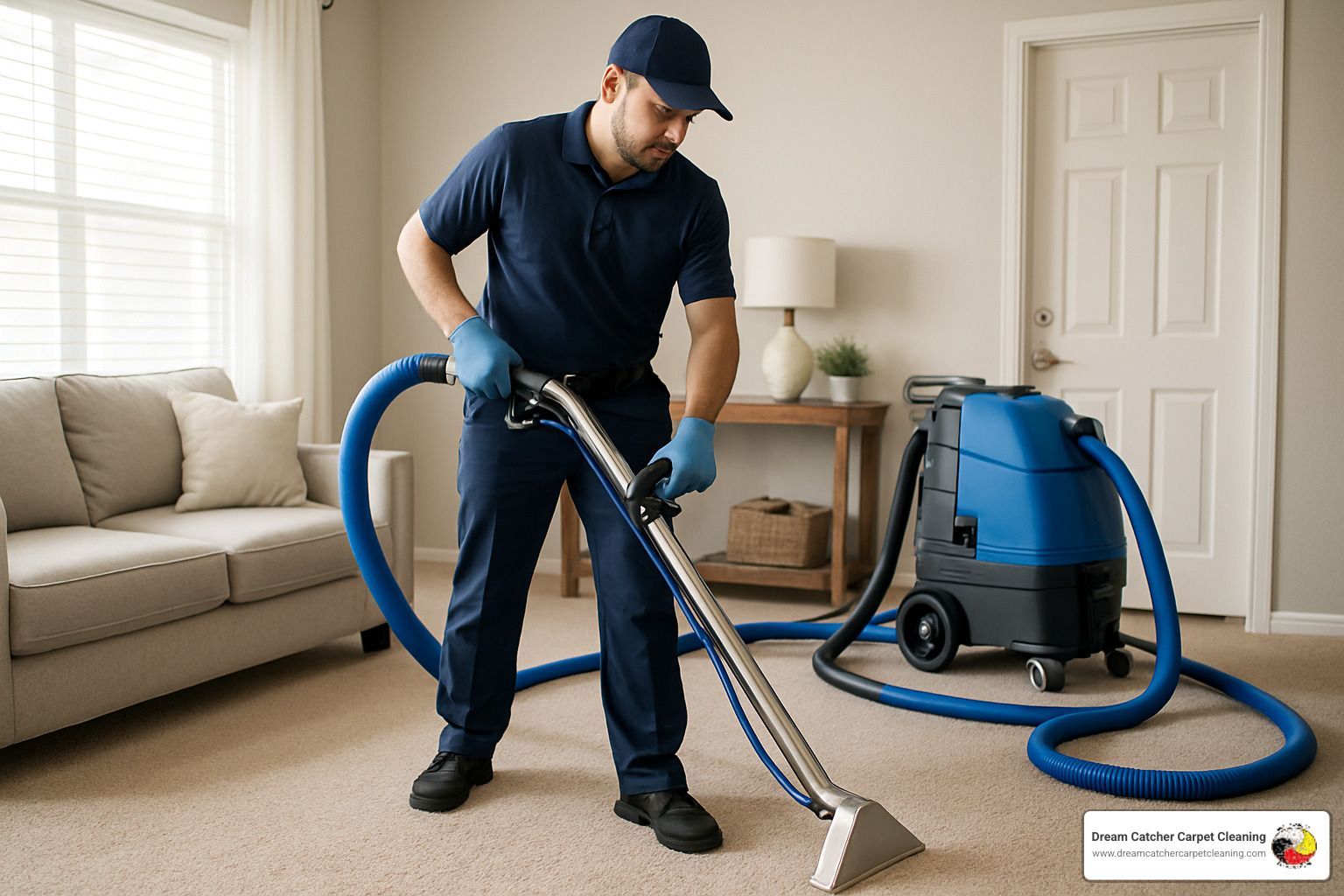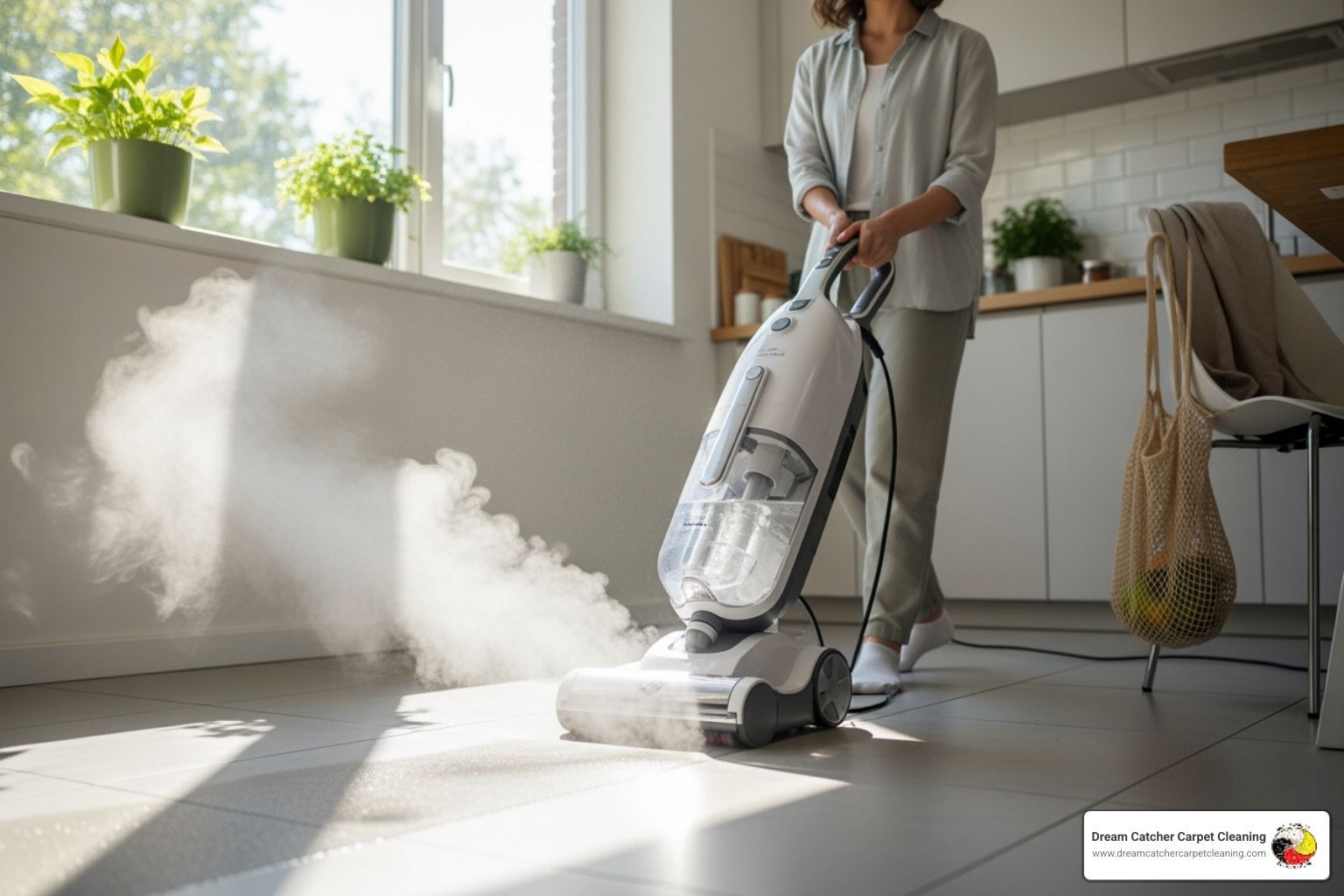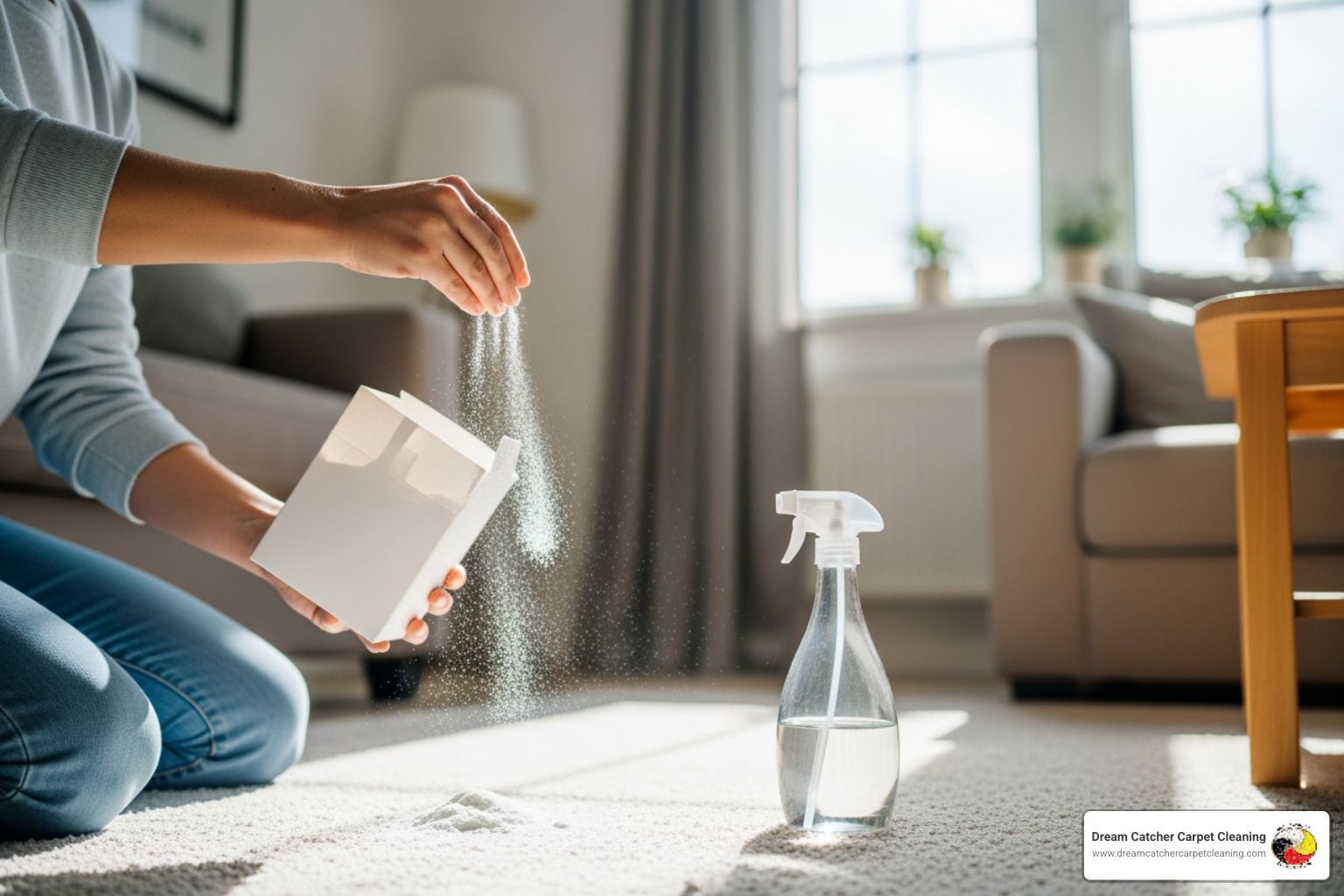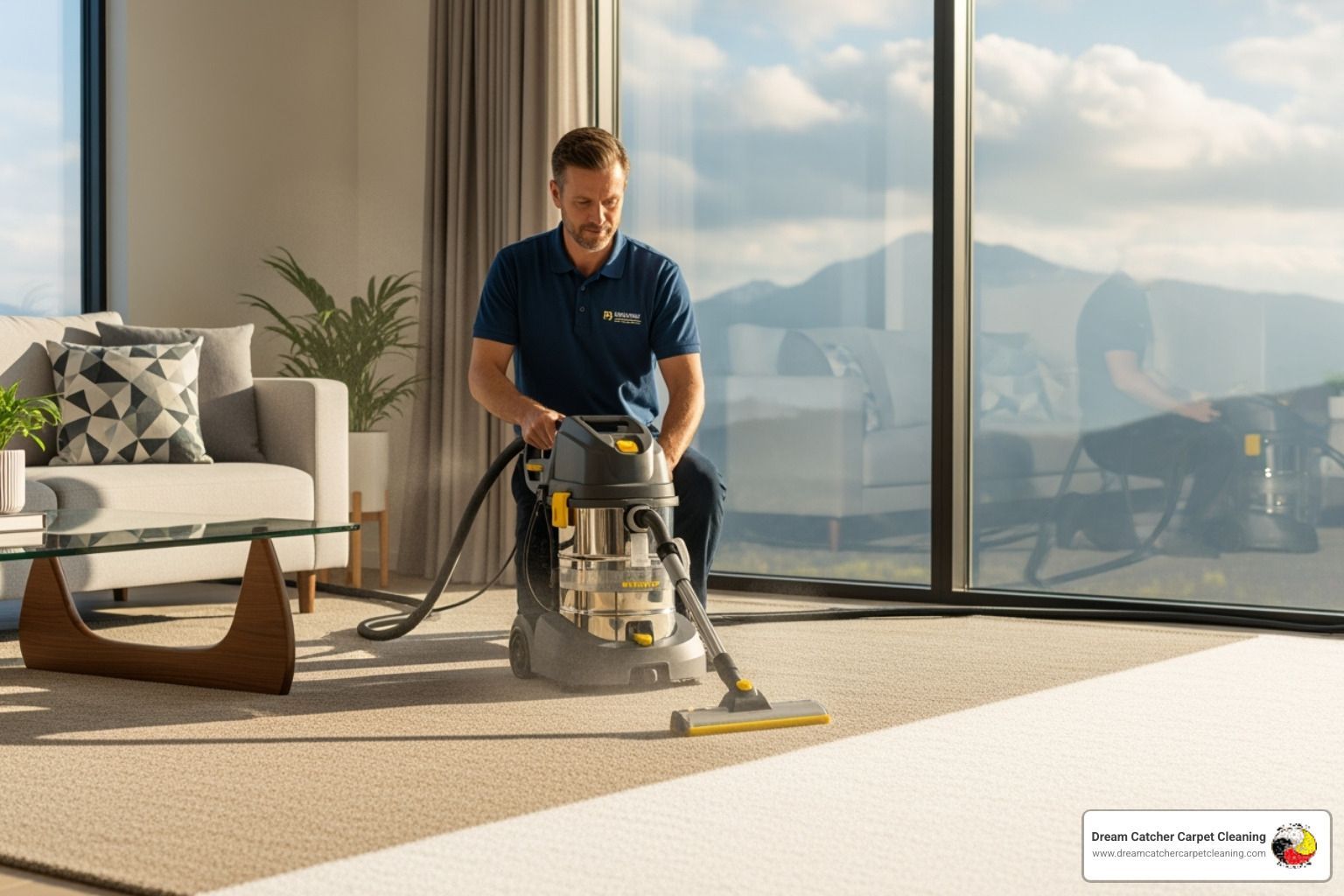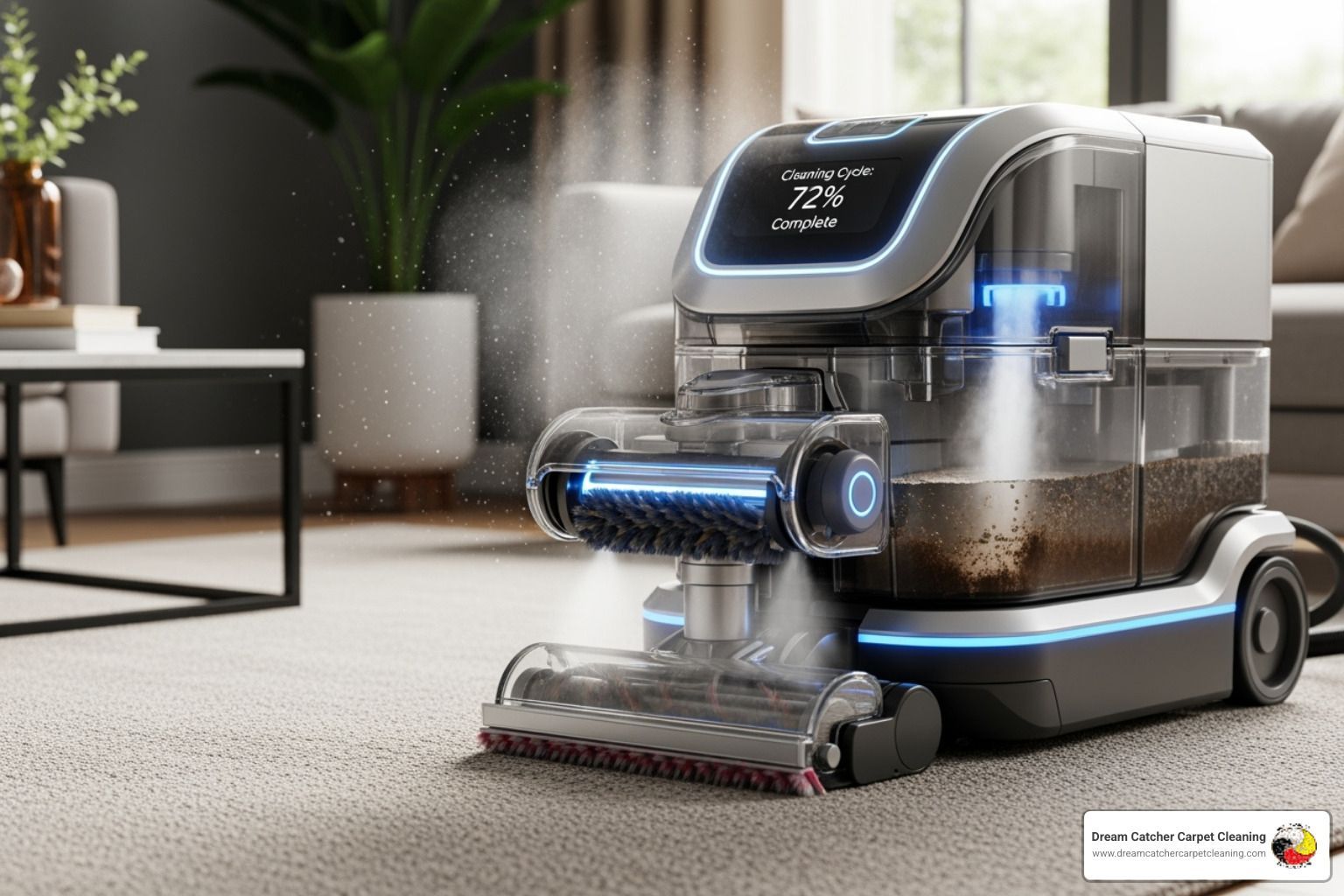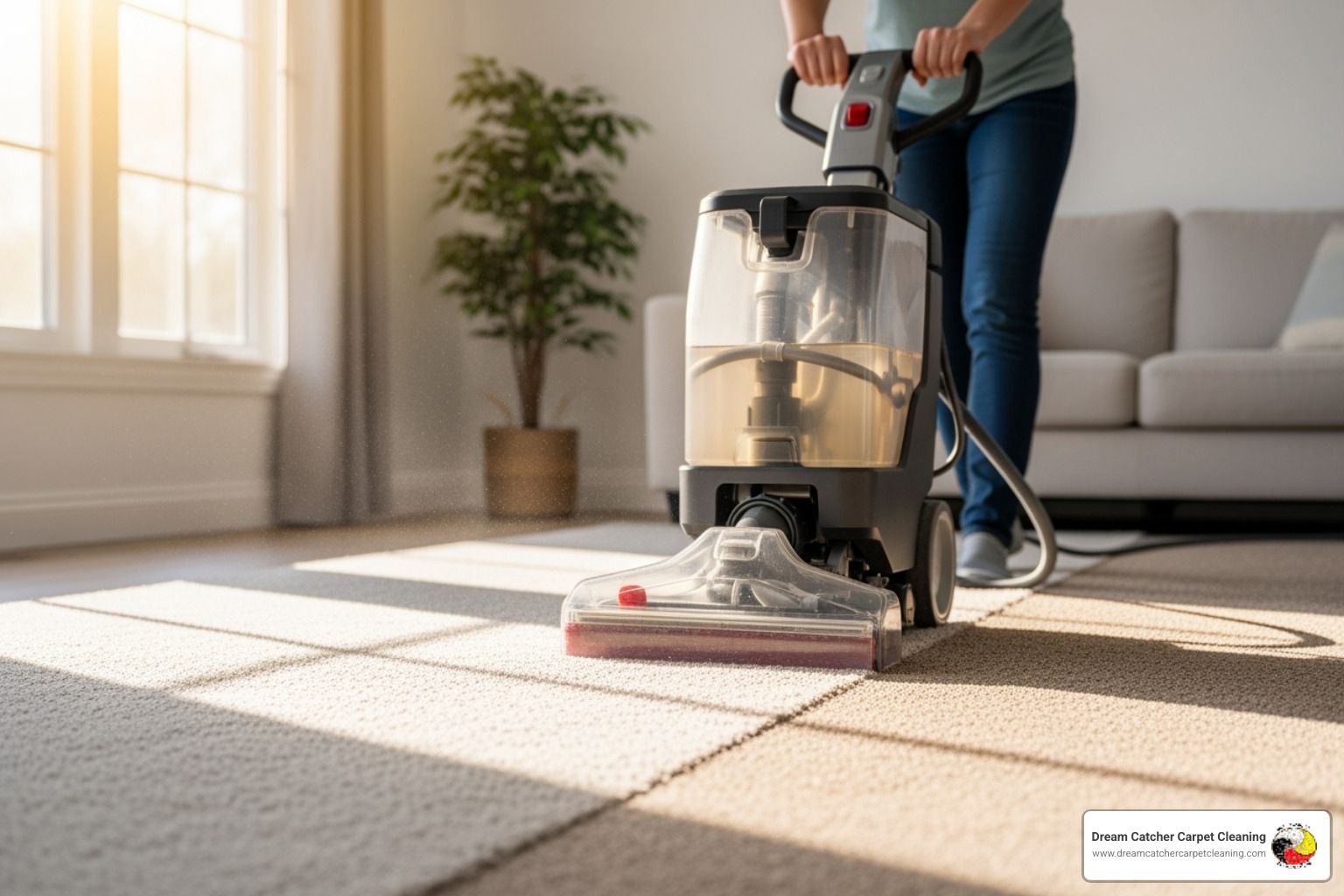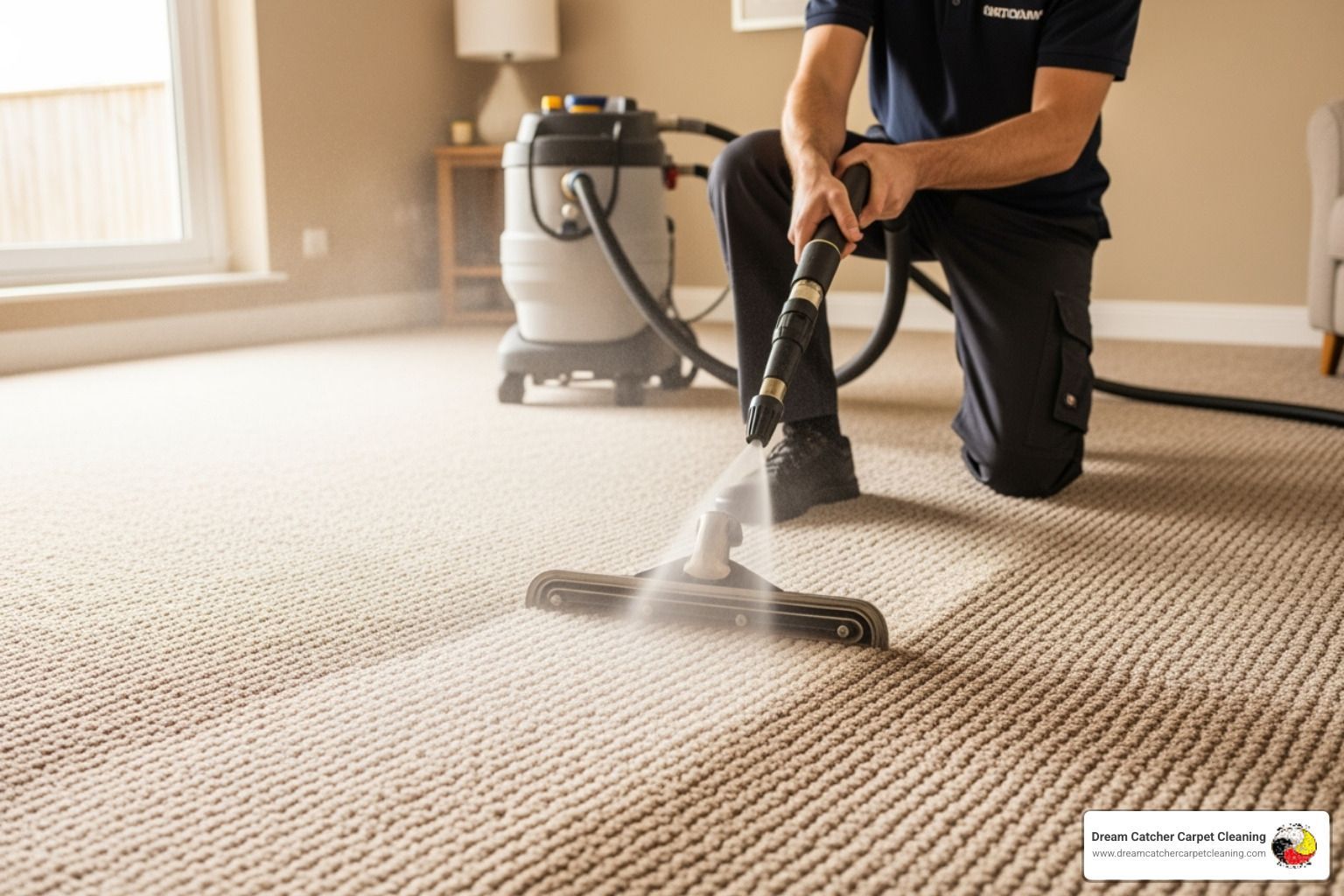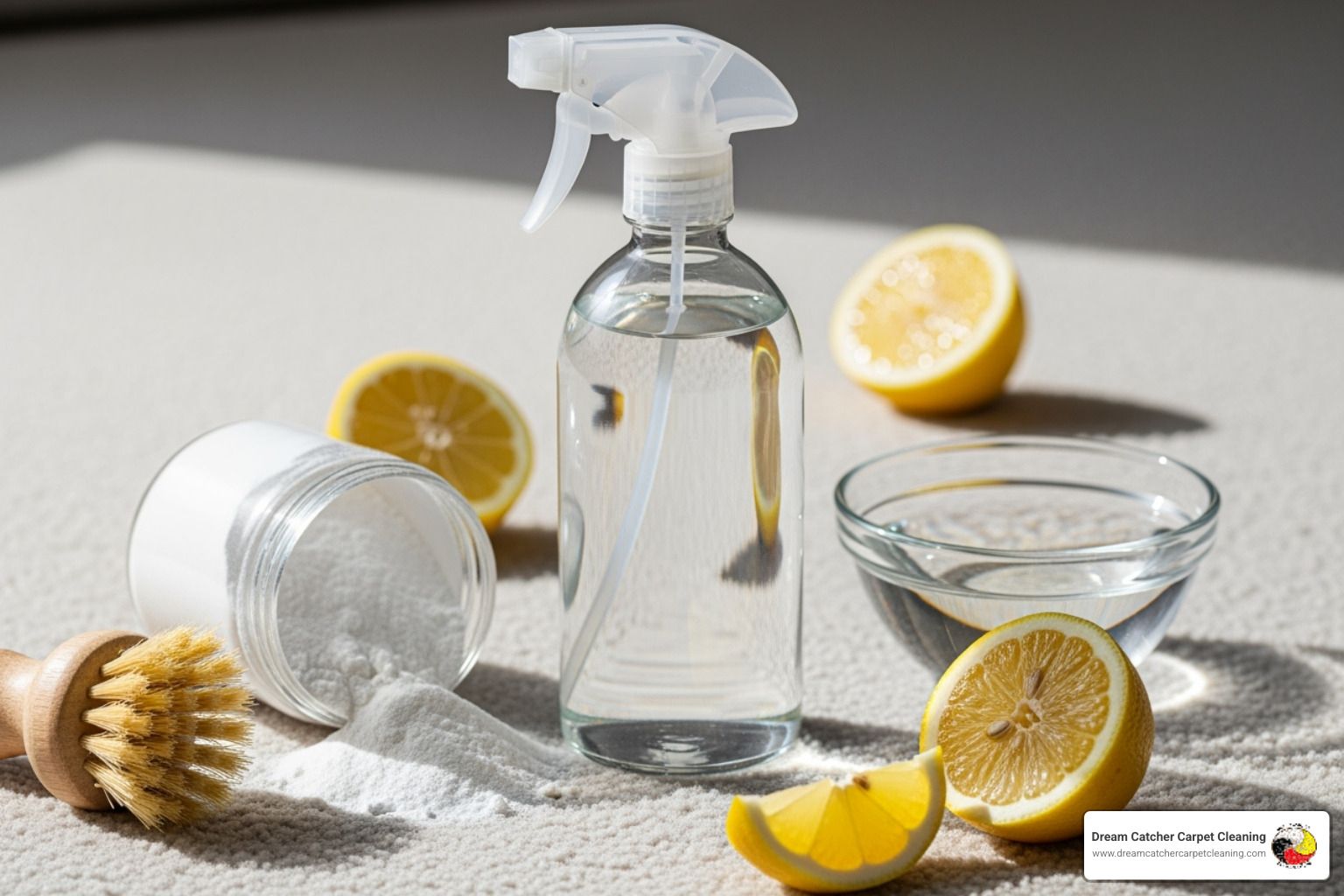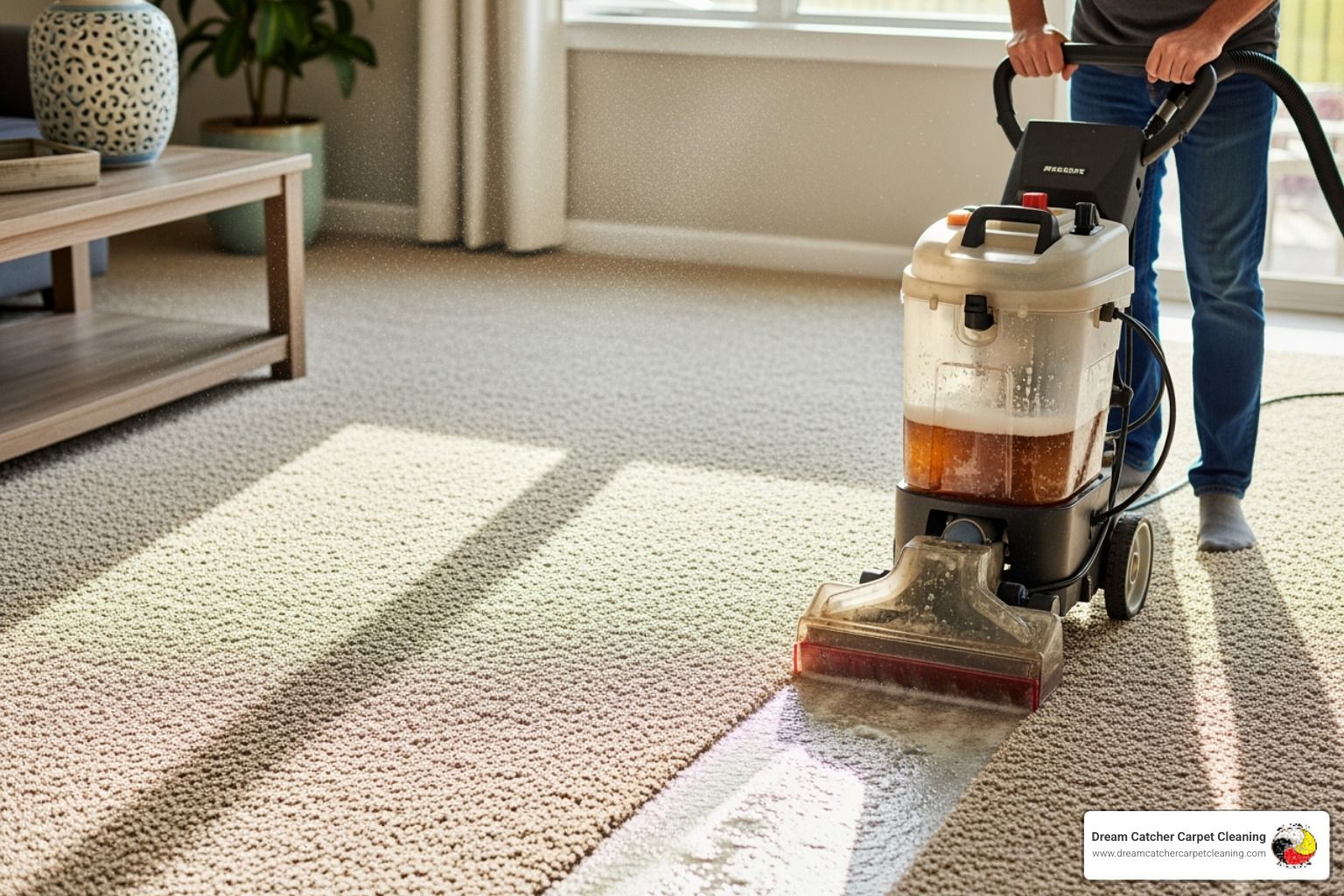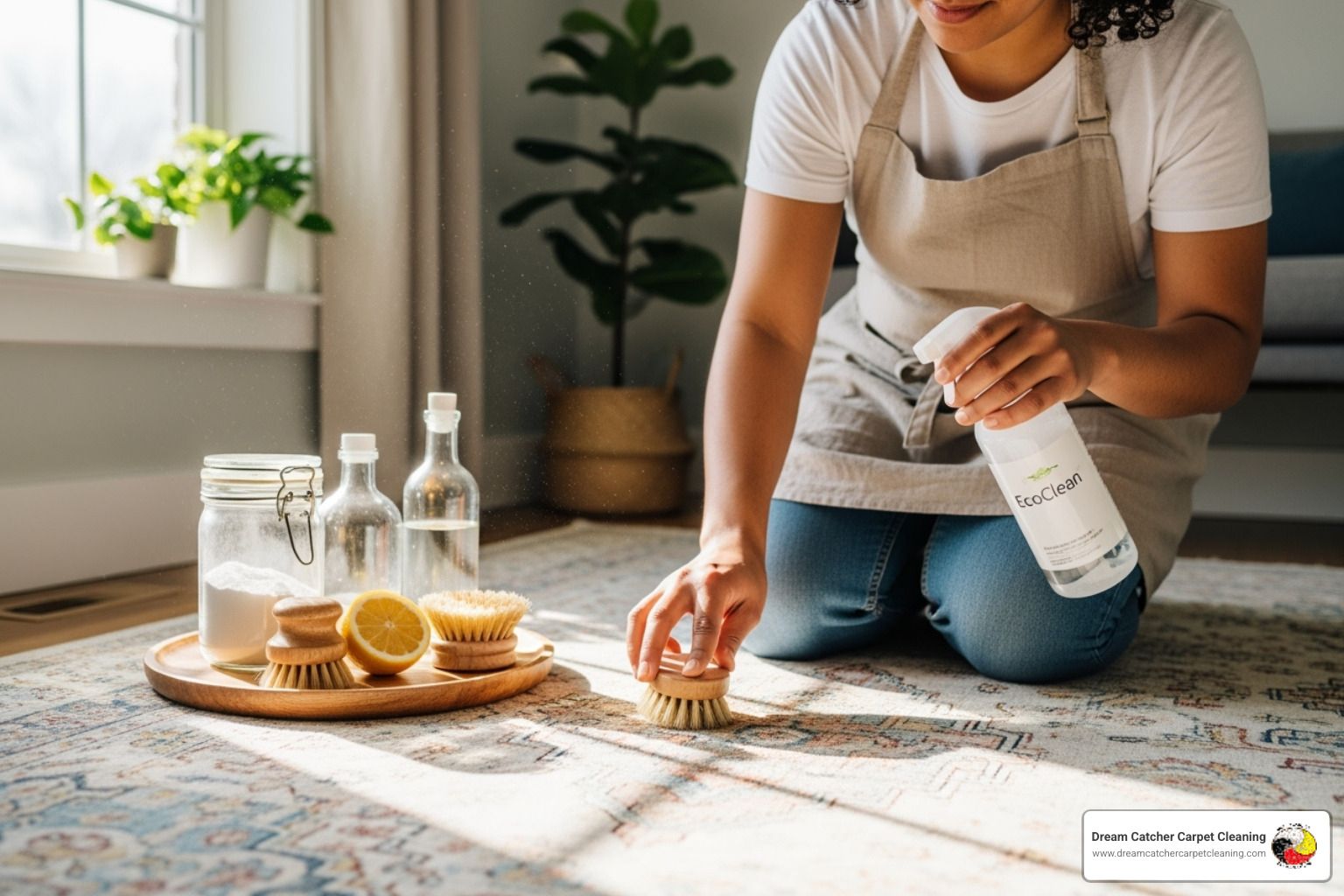Why Deep Cleaning Carpets Is Essential for a Healthy Home

If you need to deep clean your carpets, here's a quick answer:
- Vacuum thoroughly to remove surface dirt
- Pre-treat stains with appropriate cleaner
- Use hot water extraction (either rental machine or professional service)
- Allow 6-24 hours for complete drying
- Vacuum again once fully dry
Deep cleaning carpets goes far beyond regular vacuuming to remove embedded dirt, allergens, and bacteria that accumulate over time. Think of your carpet as a massive air filter for your home - it traps dust, pet dander, and other particles, but eventually needs thorough cleaning to function properly. Without deep cleaning, these trapped contaminants can affect indoor air quality and even shorten your carpet's lifespan.
Most carpet manufacturers recommend professional deep cleaning every 12-18 months to maintain warranties and keep carpets looking fresh. However, homes with pets, children, or high foot traffic may need more frequent deep cleans - sometimes as often as every 6 months.
The average home collects up to 40 pounds of dirt annually, and much of it ends up embedded in your carpets. This isn't just unsightly - it can contribute to allergies, respiratory issues, and create an unhealthy living environment. Professional deep cleaning removes an average of 94% of common household allergens from carpets.
I'm Clarence Smith, owner of Dream Catcher Carpet Cleaning with over 22 years of experience in deep cleaning carpets using environmentally safe, non-toxic solutions and German-engineered equipment. My IICRC certification ensures I provide the highest quality carpet care while prioritizing the health and safety of your family and pets.
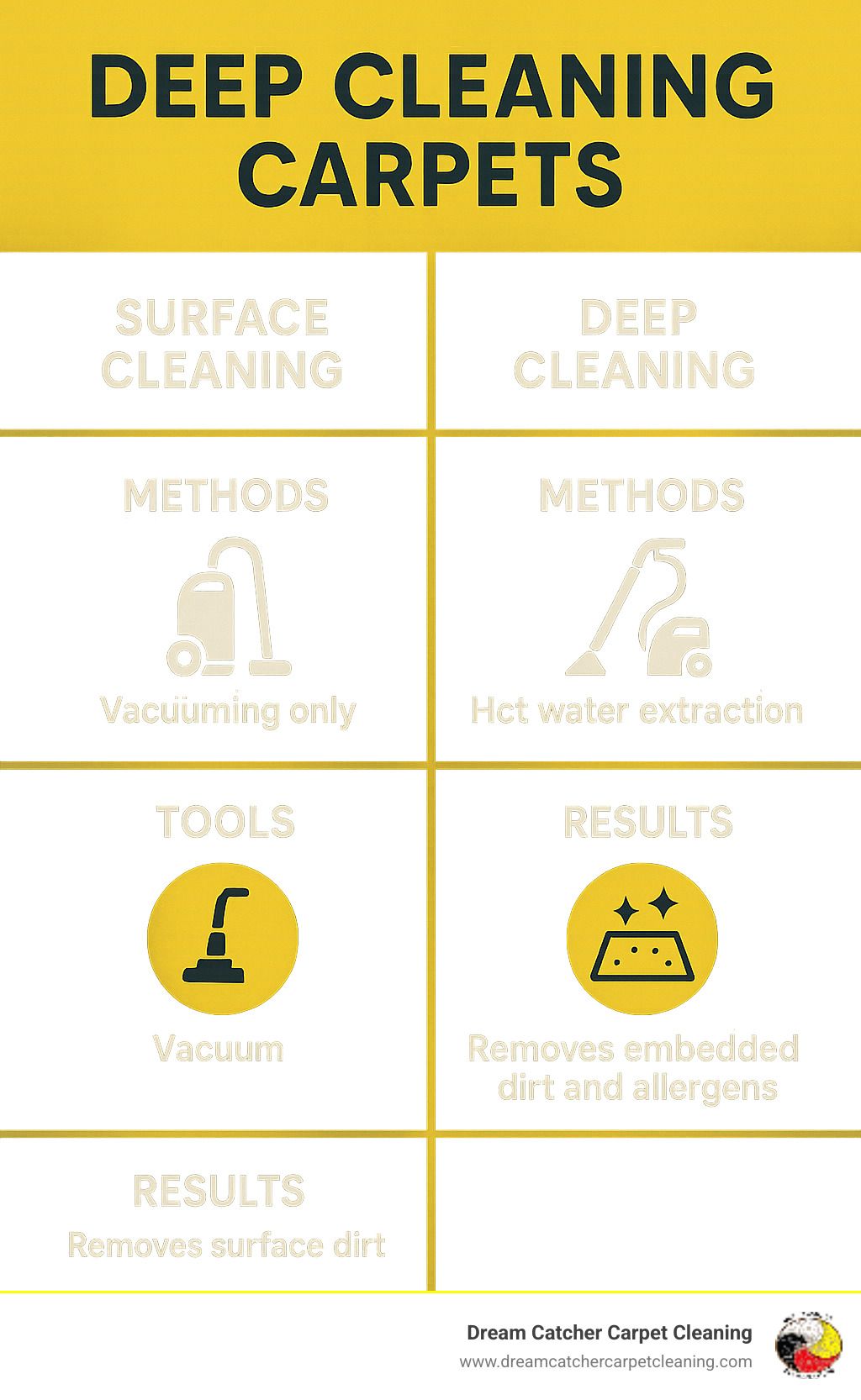
Deep Cleaning Carpets: What, Why & How Often
Ever wondered what's hiding beneath the surface of your carpets? Deep cleaning carpets goes far beyond what your vacuum can handle. It's like giving your carpets a spa day – reaching all the way down to the backing to extract dirt, allergens, and contaminants that have been settling in for months.
The results speak for themselves. Professional deep cleaning removes about 94% of common household allergens lurking in your carpet fibers. That's not just about having a cleaner-looking home – it's about creating a healthier space where you and your family can breathe easier.
Your carpets are an investment, and deep cleaning helps protect that investment. Those tiny particles of dirt act like sandpaper, slowly wearing down carpet fibers every time you walk across them. Regular deep cleaning removes these abrasive particles, extending your carpet's life significantly. In fact, many carpet manufacturers require professional cleaning every 12-18 months to keep your warranty valid.
The Carpet and Rug Institute (CRI) recommends a simple maintenance routine: tackle spills immediately with spot cleaning, vacuum thoroughly each week, and schedule professional deep cleaning every 12-18 months. This simple routine can add years to your carpet's life while maintaining a healthier home environment.
Health & Hygiene Benefits of Deep Cleaning Carpets
Your carpets might look clean on the surface, but they're secretly harboring some unwelcome guests. Bacteria can survive for weeks or even months in carpet fibers. Dust mites make themselves at home, leaving behind waste products that trigger allergies. Mold spores, pet dander, and outdoor pollutants all find their way into your carpet's depths.
Deep cleaning carpets eliminates these health hazards before they can affect your family. For homes with allergy or asthma sufferers, proper carpet maintenance can be life-changing. Research shows that well-maintained carpets can actually improve indoor air quality by trapping allergens that would otherwise circulate through your home. Think of your carpet as a giant air filter – but like any filter, it needs regular cleaning to function properly.
Moisture is another concern with carpets. When they remain damp after improper cleaning, mold can develop within just 24-48 hours. Professional equipment provides powerful extraction that removes most moisture, significantly reducing this risk and keeping your home healthier.
How Often Should You Deep Clean
While the standard recommendation is every 12-18 months, your household might need more frequent attention. If you have four-legged family members, consider deep cleaning every 6-12 months to handle pet dander, accidents, and the extra dirt they track in. Homes with children follow a similar schedule – those little ones are adorable, but they're also professional mess-makers!
Smokers should schedule cleanings every 6 months to remove smoke residue and odors. Love hosting gatherings? The increased foot traffic and inevitable spills might require cleaning every 6-12 months. And if anyone in your home suffers from allergies, semi-annual cleanings can make a world of difference in reducing symptoms.
Many homeowners find that seasonal deep cleaning works perfectly with their home maintenance routines. Spring and fall cleanings coincide nicely with other seasonal tasks, creating a natural rhythm for home care.
Not all areas of your home need the same level of attention. High-traffic zones like hallways, entryways, and family rooms might need more frequent care than your rarely-used guest room or formal living area. Consider spot-cleaning these busy areas between full deep cleanings for best results.
Understanding Carpet Types & Fibers
Your carpet's material determines the best cleaning approach. Natural fibers like wool offer incredible durability but absorb water readily. They require gentle cleaning with minimal moisture and specialized wool-safe products to prevent damage.
Synthetic fibers are more common in modern homes. Nylon, the most popular choice, offers excellent durability and responds well to hot water extraction. Polyester provides good stain resistance but can mat down in busy areas. It handles most cleaning methods well. Olefin/Polypropylene works great in basements and outdoor spaces due to its moisture resistance, though it tends to attract oils while repelling water-based stains.
Before diving into any deep cleaning project, always perform a quick colorfastness test in an inconspicuous area. Simply dampen a white cloth with your cleaning solution, gently rub it on a hidden section of carpet, and check for any color transfer. If you see dye on your cloth, it's time to consider a different cleaning method or call in the professionals.
At Dream Catcher Carpet Cleaning, we tailor our approach to your specific carpet type. We understand that your carpets are an investment, and our cleaning methods ensure the safest, most effective treatment for your particular fibers. Our knowledge of different carpet materials means we can provide the perfect level of care, whether you have delicate wool or durable synthetics.
Scientific research on indoor allergens confirms that regular deep cleaning is one of the most effective ways to maintain healthy indoor air quality and reduce common household allergens. For more information about how allergens affect your home environment, check out this helpful resource from WebMD.
DIY vs Professional: Methods, Gear & Cost
When it comes to deep cleaning carpets, you're faced with a choice that many homeowners wrestle with: roll up your sleeves and do it yourself, or call in the professionals. Both paths can lead to cleaner carpets, but they differ significantly in methods, equipment, and what they'll cost you.
Pros & Cons of DIY Deep Cleaning Carpets
Taking the DIY route can be appealing for many reasons. For starters, your wallet might thank you – rental machines typically run between $40-$100 per day, plus another $15-$30 for cleaning solution. That's substantially less than professional services.
The flexibility is another major plus. You can tackle that grape juice stain at 9 PM on a Tuesday if that's when you have time. You're also in complete control of which products touch your carpet, which is particularly important if you have pets, children, or chemical sensitivities.
But before you rush to the rental counter, consider the trade-offs. Those rental machines simply can't match the power of professional equipment. This means more passes over the same areas, more physical effort, and carpets that might take a full day or longer to dry completely.
There's also a real risk of overwetting your carpets if you're not experienced. Too much moisture that isn't properly extracted can lead to mold growth, mildew odors, and even damage to your carpet backing. And let's be honest – there's definitely a learning curve. Your first DIY carpet cleaning trip might take 3-8 hours depending on your space, and the results might not be what you hoped for.
DIY deep cleaning makes the most sense when you're maintaining carpets between professional visits, addressing small isolated stains, or working with lightly soiled carpets in a budget-conscious home.
Advantages of Hiring a Pro
Professional deep cleaning carpet services offer some compelling benefits that are hard to ignore. The equipment difference alone is substantial – truck-mounted systems provide 5-10 times more vacuum power than anything you can rent, which translates to more dirt removed and faster drying times (typically 6-12 hours versus 12-24 for DIY).
Beyond equipment, you're paying for expertise. Trained technicians can identify your specific carpet type and adjust their approach accordingly. They know which stain removers work on which stains, how much pressure to apply, and how to avoid common pitfalls that can damage carpet fibers.
At Dream Catcher Carpet Cleaning, our truck-mounted hot water extraction system has earned Platinum certification from the Carpet and Rug Institute. This means we're removing the maximum amount of soil while leaving minimal residue behind. Our specialized CRB German machine provides exceptional results by gently agitating carpet fibers to release deeply embedded dirt before extraction.
The time savings are substantial too – professionals can typically clean an entire home in 2-3 hours, freeing you up to focus on other things. Many professional services also offer additional treatments like carpet protectors, deodorizers, and sanitizers that aren't available in rental units.
Perhaps most importantly for newer carpets, many manufacturers require professional cleaning to maintain warranty coverage, making the professional route necessary rather than optional.
For more information about our professional carpet cleaning process, visit our detailed process page.
Essential Equipment & Supplies
Whether you're going the DIY route or preparing for professional service, certain tools and supplies are essential for effective deep cleaning carpets.
For DIY cleaning, you'll need an upright vacuum for pre and post-cleaning, a carpet cleaner/extractor (rented or purchased), and a carpet brush for working cleaning solutions into stubborn stains. You'll also want appropriate stain pre-treatments, carpet cleaning solution matched to your carpet type, fans to speed drying, furniture sliders to protect both furniture and carpet, and clean white towels for blotting and progress checks.
Some product recommendations that yield good results include PRO MAX Clean + Protect formula for rental extractors, PET PRO OXY Stain Destroyer for pre-treating those stubborn pet stains, and microfiber towels that blot effectively without leaving lint behind. A quality carpet brush is also essential for working solutions into stubborn stains.
If you're preparing for professional cleaning, your needs are simpler but still important. You'll want to vacuum to remove surface debris before the professionals arrive, clear small items from carpeted areas, decide which furniture pieces to move or leave in place, and make note of problem areas so you can point them out to the technicians.

Both approaches can give you cleaner, fresher carpets, but understanding the differences helps you make the choice that's right for your specific situation, budget, and carpet care needs.
Deep Cleaning Carpets at Home: Step-by-Step, Stain Removal & Drying
If you've decided to tackle deep cleaning carpets yourself, following a systematic approach will yield the best results. Here's our comprehensive guide to doing it right.
Preparing the Room & Carpet
Proper preparation is crucial for effective deep cleaning:
- Declutter the space: Remove small items, toys, and decorative objects
- Move furniture: Clear as much furniture as possible, or at minimum, move pieces to clean underneath them in sections
- Protect furniture legs: Place aluminum foil or plastic under furniture legs to prevent wood stains or rust marks
- Address visible stains: Pre-treat problem areas before general cleaning
- Vacuum thoroughly: Make several passes in different directions, paying special attention to high-traffic areas and edges
Pro tip: Vacuum in two perpendicular directions to more effectively remove embedded dirt. Use attachments to clean edges where dirt and dust accumulate against baseboards.
Machine Method for Deep Cleaning Carpets
Hot water extraction (often called steam cleaning) is the most effective DIY method:
- Rent or purchase a carpet cleaner: Select a unit with good suction power
- Read the machine instructions: Familiarize yourself with controls and operation
- Fill tanks properly: Add hot (not boiling) water and the recommended amount of cleaning solution
- Test in an inconspicuous area: Check for colorfastness and reaction
- Start cleaning from the farthest corner: Work backward toward the exit to avoid walking on wet carpet
- Use slow, overlapping passes: Count to two on each pass to allow scrubbing action and suction time
- Make extra dry passes: After cleaning, go over the area again with just the vacuum function to extract more moisture
For best results:
- Work in small sections (about 3×3 feet)
- Don't oversaturate the carpet
- Empty and rinse the dirty water tank when it becomes full
- Refill the clean water tank as needed with fresh solution
Alternative: If you prefer not to use commercial cleaning solutions, you can substitute with white vinegar (1 cup per gallon of hot water). Be aware this may void rental equipment warranties but provides an eco-friendly alternative.
Hand Method & Homemade Solutions
For smaller areas or those without access to machines, hand cleaning can be effective:
Basic Hand-Cleaning Method:
- Vacuum thoroughly
- Mix your cleaning solution
- Apply sparingly to a small section
- Scrub gently with a carpet brush
- Blot with clean white towels
- Rinse by blotting with clean water
- Blot again to remove moisture
- Allow to dry completely
Effective Homemade Solutions:
Vinegar Solution:
- 1 cup white vinegar
- 2 cups warm water
- 2 drops dish soap (optional) Mix in a spray bottle and apply sparingly.
Baking Soda Method:
- Sprinkle carpet liberally with baking soda
- Mix equal parts water and vinegar in a spray bottle
- Lightly mist over the baking soda (it will foam)
- Let dry completely (several hours)
- Vacuum thoroughly
Salt and Borax Paste:
- 1/4 cup (75g) salt
- 1/4 cup (100g) Borax
- 1/4 cup (59mL) white vinegar Mix to form a paste, apply to stains, let dry, then vacuum.
-
For more detailed instructions on hand cleaning methods, check out this helpful WikiHow guide.
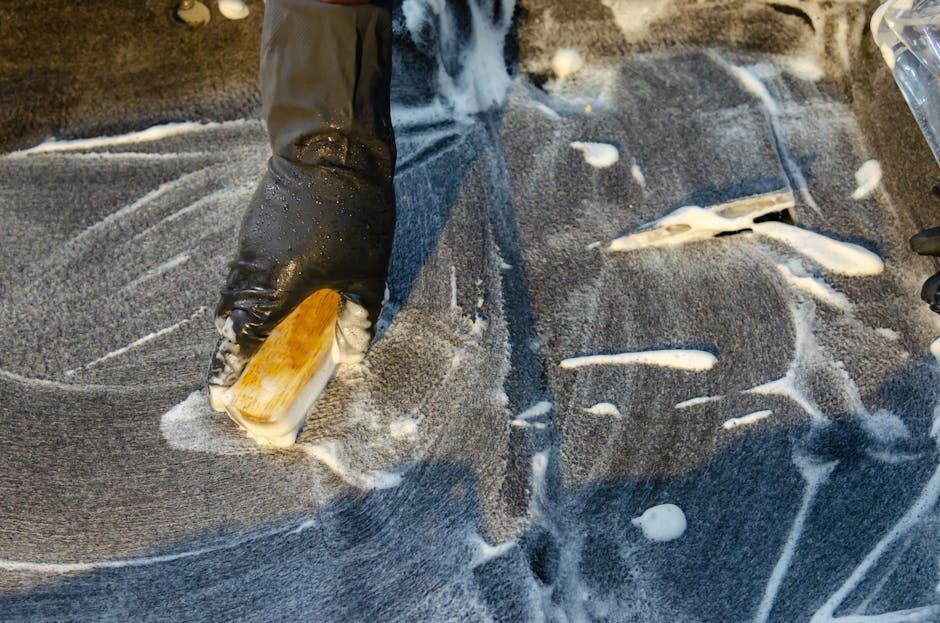
Treating Tough Stains Before Deep Clean
Pre-treating stains before general deep cleaning improves results dramatically:
Pet Urine:
- Blot fresh stains thoroughly
- Apply an enzymatic pet stain remover
- Allow to work for 10-15 minutes
- Blot, don't rub
- Rinse with clean water and blot again
Wine and Coffee:
- Blot immediately with clean cloths
- Apply salt to fresh red wine stains and let absorb overnight
- For coffee, mix 1 part hydrogen peroxide with 1 part dish soap
- Apply solution, let sit 5 minutes, then blot
- Rinse with clean water and blot dry
Gum and Wax:
- Freeze with ice cubes in a plastic bag
- Once hardened, scrape gently with a butter knife
- For remaining residue, use a mixture of dish soap, water, and vinegar
Oil and Grease:
- Cover with paper towels
- Press with a warm iron for 10 seconds
- Replace towels and repeat until oil transfers
- Treat remaining stain with dish soap solution
Blood:
- Use COLD water (never hot, which sets protein stains)
- For dried blood, mix salt with water to form a paste
- Apply paste, let dry, then vacuum
- Alternatively, use hydrogen peroxide on light carpets
For stubborn pet stains, products like PET PRO OXY Stain Destroyer can be particularly effective.
Remember to always test any stain treatment in an inconspicuous area first.
Ensuring Fast & Thorough Drying
Proper drying is critical to prevent mold, mildew, and bacterial growth:
- Maximize air circulation: Open windows if weather permits
- Use fans: Position them to create cross-ventilation
- Run HVAC system: Set to "fan" mode to circulate air
- Consider a dehumidifier: Especially helpful in humid climates
- Make extra dry passes: If using a machine, make several passes with just the vacuum function
- Avoid walking on wet carpet: Use baby gates if needed to restrict access
- Wait for complete drying: This typically takes 6-24 hours depending on conditions
Pro tip: You can speed drying by placing dry, clean towels on wet areas and pressing down to absorb moisture. Replace towels as they become damp.
The carpet should feel completely dry to the touch before replacing furniture or resuming normal use. Damp carpets can quickly develop musty odors or mold growth, especially in padding beneath.
For more comprehensive guidance on DIY carpet cleaning, visit our guide to deep cleaning carpet at home.
Long-Term Care & When to Call a Pro
Your carpets have just been deep cleaned and they look amazing! That fresh, revitalized appearance is something we all love – but how do you keep them looking that way? With some simple habits and regular attention, you can extend that just-cleaned feeling for months to come.
Maintenance Checklist After Deep Cleaning Carpets
Think of your carpet as an investment that needs regular care. Vacuuming at least once a week is your first line of defense against dirt build-up. For busy areas like hallways or family rooms, you might need to vacuum twice weekly to stay ahead of the soil.
Entry mats are carpet-savers! Place them both outside and inside every door to catch dirt before it travels throughout your home. Pair this with a no-shoes policy and you'll reduce carpet soil by up to 60% – that's more than half the dirt stopped at the door!
When spills happen (and they will), quick action makes all the difference. Blot immediately with clean white cloths, working from the outside in. Remember: blotting lifts stains while rubbing can damage fibers and spread the stain.
After investing in a deep clean, consider having a carpet protector applied. These treatments create a barrier against future stains and make regular cleaning more effective. Similarly, keeping your indoor humidity between 40-60% prevents mold growth while maintaining carpet fiber resilience.
Look for the Carpet and Rug Institute Seal of Approval on any products you use. These have been tested and proven effective without damaging carpet fibers. And don't forget to maintain your vacuum! Replace bags when they're 50-66% full and keep brushes clean of hair and threads for maximum suction power.

Small, consistent efforts make a world of difference. A little attention regularly is much easier than dealing with heavily soiled carpets once they've reached the point of no return.
For more efficient ways to maintain your carpet between professional cleanings, check out our guide on efficient ways to keep your carpet clean.
Top 3 FAQs about Deep Cleaning Carpets
I hear these questions all the time from homeowners who want to keep their carpets in top condition:
1. How long should I wait between deep cleanings?
For most homes, professional deep cleaning carpets every 12-18 months works well. But life happens! If you have pets, children, allergy sufferers, or high-traffic areas, you might need cleaning every 6-12 months instead. Your regular vacuuming and prompt attention to spills will help extend the fresh look between professional visits.
2. Is machine cleaning more effective than hand cleaning?
Machine hot water extraction generally gives you better results for whole-house cleaning. The powerful suction removes more soil and moisture than hand methods can achieve. That said, hand cleaning has its place – it works well for small areas, delicate carpets, or quick spot treatments. It just requires more elbow grease and typically doesn't clean as deeply as machines can.
3. How long until my carpet is completely dry after deep cleaning?
This depends on several factors. Professional hot water extraction typically dries in 6-12 hours, while DIY machine cleaning might take 12-24 hours. Hand-cleaned spots usually dry in 4-8 hours. Good airflow makes a huge difference! Open windows (weather permitting), run fans, or set your HVAC to "fan" mode to speed things up. Always make sure carpets are completely dry before resuming normal use – damp carpets are magnets for new soil and potential mold.
Signs It's Time for Professional Deep Cleaning Carpets
Sometimes your carpets will tell you when they need professional attention. Watch for these signals:
When you notice visible traffic patterns where pathways look darker than surrounding areas, that's embedded soil that regular vacuuming can't remove. Similarly, stubborn stains that resist your cleaning attempts are calling for professional help.
Persistent odors – especially those pet smells that seem to return after your cleaning efforts – indicate deep-seated issues that need professional equipment to resolve. If household members experience increased allergy symptoms like sneezing or irritation, your carpets might be harboring allergens.
When your carpet starts to look flat or matted and loses its springy texture, professional cleaning can help restore its resilience. And if it's been over 18 months since your last professional cleaning, it's definitely time to schedule service.
Don't forget about your warranty requirements – most carpet manufacturers require professional cleaning every 12-18 months to keep warranties valid. After any water damage, prompt professional cleaning is essential to prevent mold growth.
At Dream Catcher Carpet Cleaning, we use specialized equipment that goes well beyond rental machines. Our CRB German machine provides exceptional results by thoroughly agitating carpet fibers to release deeply embedded dirt before our powerful truck-mounted extraction system removes it completely. Learn more about our superior results with the CRB German Machine.
For those especially challenging situations, we offer specialized services including pet odor neutralization, advanced stain removal techniques, carpet protector application, and sanitizing treatments – all using eco-friendly, non-toxic cleaning solutions.

Professional cleaning also ensures proper wastewater disposal – an environmental consideration that's often overlooked when cleaning at home. When you choose professional service, you're not just getting cleaner carpets; you're making an eco-friendly choice too.
Conclusion
Deep cleaning carpets isn't just a chore—it's an investment in your home's health and comfort. Whether you've rolled up your sleeves for a DIY deep clean or called in the professionals, you've taken an important step toward creating a fresher, healthier living space for you and your family.
As we've explored together, proper carpet care goes beyond appearances. Those soft fibers beneath your feet act as your home's largest air filter, trapping allergens and contaminants that would otherwise circulate in your breathing space. By maintaining them properly, you're actually supporting better indoor air quality and potentially reducing allergy symptoms for everyone in your household.
Remember these five essential takeaways for keeping your carpets in top condition:
Regular maintenance matters – Weekly vacuuming and immediate attention to spills will significantly extend the time between deep cleanings. Think of it as brushing your teeth daily versus only seeing the dentist!
Know your carpet type – Your carpet's fiber composition determines the best cleaning approach. Wool, nylon, polyester, and olefin each respond differently to cleaning methods and products.
Proper preparation is crucial – Taking time to prepare your space before cleaning—removing furniture, pre-treating stains, and thorough vacuuming—dramatically improves your final results.
Thorough drying prevents problems – Complete drying isn't just about getting back to normal quickly; it prevents mold growth, musty odors, and rapid resoiling that can happen with damp carpets.
Schedule regular professional cleanings – Even with diligent home care, professional deep cleaning every 12-18 months (or more frequently for busy households) is essential for maintaining carpet warranties and extending carpet life.
At Dream Catcher Carpet Cleaning, we understand that your home is your sanctuary. That's why we've spent over two decades perfecting our craft, using only non-toxic, environmentally safe cleaning solutions that effectively remove dirt and stains without leaving harmful residues behind. Our IICRC-certified technicians bring specialized knowledge and state-of-the-art equipment to every job, ensuring your carpets not only look better but are genuinely cleaner from backing to surface.
We proudly serve the North Metro Denver area, including Thornton, Denver, Boulder, and Westminster, bringing our passion for healthy homes to every carpet we clean. Our specialized CRB German machine provides superior results that simply can't be matched by rental equipment, while our eco-friendly approach means your carpets are safe for children, pets, and family members with sensitivities.
The next time your carpets need refreshing, proper deep cleaning isn't just about appearances—it's about creating a healthier home environment where your family can thrive. We'd be honored to help you maintain beautiful, fresh carpets that stand the test of time.
For more information about our professional carpet cleaning services, visit our professional carpet cleaning page.
